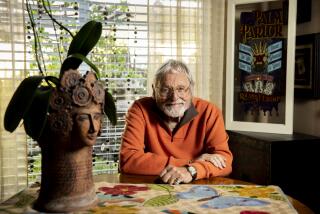‘Gehry’ intriguing but a bit behind the curve
- Share via
Architecture is the slowest of the arts, by far: It often takes a full decade for a building to go from sketch to ribbon-cutting, a journey that can be pushed off course by zoning officials, fussy clients and the laws of gravity. But in “Sketches of Frank Gehry,” director and first-time documentarian Sydney Pollack manages to make his own art form look like the sluggish one.
Although cannily structured and consistently entertaining -- no picture that gives us Julian Schnabel analyzing the design of the Guggenheim Museum in Bilbao, Spain, while wearing sunglasses and a robe and swigging brandy ought to be dismissed outright -- the movie, as an exploration of Gehry’s talents and his legacy, is more than a little out of date.
In the last three years or so, Gehry has moved into a phase of work that marks largely uncharted territory for American architecture, combining 21st century architectural celebrity with a return to the 1960s-style mega-project. In downtown Los Angeles and in Brooklyn, his firm, best known for dazzling museums, concert halls and private residences, has been hired by prominent developers to design huge, mixed-use commercial projects that hold the potential to permanently change the fate of surrounding neighborhoods.
The story of how an architect who loves to cast himself as an outsider, frequently wronged or overlooked and whose work was long thought to be either too messily unpredictable or simply too ugly for most commercial clients, wound up winning these jobs is a fascinating one.
So is the conflict between Gehry’s references to himself as a “liberal do-gooder” -- not to mention the joyful, unbuttoned populism of his best buildings -- and the bitter community-opposition that the giant Brooklyn project in particular has lately aroused. Not since the days of Robert Moses squaring off against Jane Jacobs has there been so much noisy conflict about new architecture in our cities.
None of that makes it into the documentary. Pollack seems to have wrapped up shooting not long after the Walt Disney Concert Hall opened 2 1/2 years ago. Instead, the director, who wears his own naivete about design as a badge of honor, is interested in exploring architecture as a primarily formal art detached from the rest of the culture -- as extra-large sculpture, essentially.
Pollack does give a substantial chunk of screen time to Milton Wexler, Gehry’s longtime analyst, who proves to be a winning, charismatic presence. Those interviews set the tone for a documentary that insists on treating Gehry as an introspective, tortured creator and steers as far away as possible from the intersection of architecture and politics.
Instead, Pollack has recruited a group of celebrity talking heads to rave about how Gehry’s initial design concepts are turned, through the magic of computer-aided design, into buildings. They include Michael Eisner, for whom Gehry designed a hockey practice facility in Anaheim for the NHL’s Mighty Ducks, and rocker Bob Geldof, who once caught a glimpse of Gehry’s furniture showroom in Vitra, Germany, from his tour bus.
Mike Ovitz, Barry Diller and Ed Ruscha appear as well. “Frank really lives in the moment,” Dennis Hopper declares. Only Schnabel, from behind his shades, seems to understand the degree to which theatricality will wind up driving Pollack’s stab at feature-length nonfiction filmmaking. Gehry, who changed his name from Goldberg as a young man, has always been a savvy packager of his own legend. His friend Pollack is only the latest to help him pick out the pretty wrapping paper.
To be fair, Gehry’s recent work is among the most aggressively sculptural in contemporary architecture, so there’s no shortage of material to be mined in that particular vein. Pollack has strung together a remarkable collection of shots of Gehry’s work from Seattle to Bilbao that ends with fireworks over Disney Hall.
Still, many scenes showing Gehry and his design partners Craig Webb and Edwin Chan at work in the Gehry Partners office play like a parody of the creative process. Even the professional critics who take part have been rendered toothless by Pollack’s approach to the subject -- or simply by Karen Schmeer’s editing. Former New York Times architecture critic Herbert Muschamp, usually the most piquant of architectural commentators, manages only banal praise for Gehry’s work. The critic Hal Foster, enlisted to offer a dissenting voice, is the very picture of timid ambivalence, the perfect foil for Pollack’s Gehry, a man of creative action who also happens to be three decades into therapy.
Speaking of action, some very telling comments come from Charles Jencks, a critic and landscape architect and a longtime Friend of Gehry. In describing Gehry’s own house in Santa Monica, a pink bungalow that he famously redesigned by wrapping it in glass and chain-link, Jencks offers up a story about how Gehry was trying to shave in an upstairs bathroom one morning and found the room too dark.
Gehry responded, Jencks says, by knocking a hole in the ceiling and shaving triumphantly by the “California light” pouring through. I suppose that is an example of living in the moment. It’s also the kind of anecdote Europeans (Jencks was born in Baltimore but has worked for most of his career in Great Britain and has the upper-crusty lilt to show for it) and New Yorkers love to tell about California, where even our most talented, savvy and politically connected architects are little more than resourceful savages, living by their wits and their sledgehammers alone.
*
‘Sketches of Frank Gehry’
MPAA rating: PG-13 for brief strong language.
A Sony Pictures Classics release. Director Sydney Pollack. Producer Ultan Guilfoyle. Cinematographers George Tiffin, Claudio Rocha, Marcus Birsel. Editor Karen Schmeer. Running time: 1 hour, 22 minutes. In selected theaters.
More to Read
The biggest entertainment stories
Get our big stories about Hollywood, film, television, music, arts, culture and more right in your inbox as soon as they publish.
You may occasionally receive promotional content from the Los Angeles Times.











